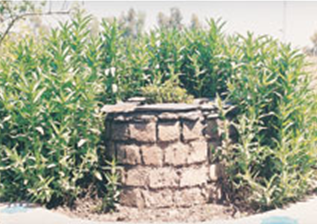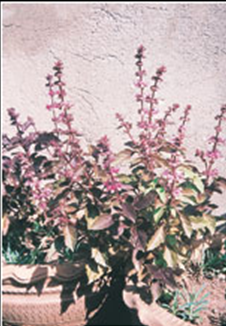Tukh Malanga/ Sabza (Sweet Basil Seed/ Ocimum basilicum)
(Created page with " {| class="wikitable" |- |colspan="0"|<div style="font-size:100%"> This is a collection of articles archived for the excellence of their content.<br/>You can help by convertin...") |
|||
| Line 14: | Line 14: | ||
[[Category:Name|Alphabet]] | [[Category:Name|Alphabet]] | ||
| − | + | =Tantalising Tukh-Malanga= | |
| − | + | By Zahrah Nasir | |
Revision as of 10:29, 4 November 2013
This is a collection of articles archived for the excellence of their content. Readers will be able to edit existing articles and post new articles directly |
Tantalising Tukh-Malanga
By Zahrah Nasir
Zahrah Nasir throws light on the history and botanical characteristics of sweet basil and provides useful information on growing the herb
This wonderful Urdu name of the plant rolls pleasantly around the mouth leaving a very intriguing after taste for those who have not actually got around to sampling the seed in question. Also known as naz boo, a second Urdu name for the same family of herbs, tukh-malanga is the seed of that all time favourite sweet basil, or basilicum ocimum to be botanically correct.
Traditionally, tukh-malanga seed sold in surprisingly large quantities, is soaked in water and then added to summer sherbets and faluda for its well known cooling effect. Not many people realise that the seed is the sweet basil which they repeatedly request the owners of regular seed stores to supply them with, often without any luck, in order to add this very versatile herb to their gardens!
Sweet basil, and just to stir the linguistic pot a little more, is not the tulsi which many people confuse it with. Tulsi, yet another Urdu name, is a perennial variety of basil, revered by Hindus who also call it sacred basil whilst sweet basil is an annual variety. Tulsi, to make the difference even more apparent, has rather tough, slightly hairy leaves and stems, the stems when cut into bead shapes and strung in to necklaces claim to protect the wearer from evil, but the leaves and stems of sweet basil are very soft and tender to the touch, so much so in fact that they must be handled lightly in order to avoid bruising and discolouration.
Back to tukh-malanga before I get side-tracked again, sweet basil is native to the subcontinent and Africa and it is a historical fact that Alexander the Great, something of a botanist when he wasn’t subjugating people and their countries, was so impressed by it that he sent samples of the plant and lots of seed back home to Greece where it quickly became established before moving on to Rome where the Italians still make full use of it in their delectable cuisine.
However, and this is the ‘twist’, for some unknown reason the Greeks came to associate basil with all manner of evil, though this, by the way, didn’t prevent them from using it as an ingredient in love potions, and some bright spark came up with the theory that unless you soundly, roundly and very nastily curse the seed when planting it then it won’t grow!
This tradition also spread to Italy and throughout the rest of Europe but I do not know if it is still practised as I have not been in the vicinity when basil sowing is in process. I most certainly do not curse my basil seeds during the planting process but talk to them rather nicely instead, but come to think of it, I may be mumbling, certainly thinking, “Germinate and grow up so I can cut you to pieces and eat you!” Logical isn't it?
Now that all of the above is out of the way I will tell you some more about tukh-malanga and its many uses. For a start, the seed has completely different uses than the actual plant and, as for those of you who are familiar with it will know, when soaked in water the seeds quickly develop a highly mucilaginous coating, an almost transparent, whitish, jelly-like substance which, along with the seed itself, is highly regarded for its cooling and tonic properties in locations as diverse as the Caribbean Islands, South and North America, Europe, China, Malaysia and, of course, the subcontinent where it is an ingredient of numerous herbal medicines.
Sweet basil, the entire plant not just the leaves, is considered to be a restorative herb which lowers fever, helps digestion, cures bacterial infections and gets rid of intestinal parasites. An extract of the plant is popular for the relief of colds and influenza, to relieve nausea, migraine, anxiety and exhaustion. A different preparation is used to clear up acne, treat insect bites, skin infections and even snake bites. The oil is in high demand in the perfume industry and is also added to dental hygiene products and fancy, high quality soaps. The leaves have so many culinary uses that one could devote an entire recipe book to the subject! Another interesting fact is that whilst the seeds are renowned for their cooling effect, the rest of the plant is directly opposite being ‘warming’ to the human system.
Having ploughed your way this far, perhaps you would like to know how to grow sweet basil for yourself and, this I guarantee is nowhere near as complicated as the previous discourse may lead you to believe! Basil, in all of its forms, is one of the easiest and most rewarding herbs to grow in your garden or in suitable containers on a balcony or patio. Soil need not be terribly rich but must be well drained as water-logging causes the plants, particularly young seedlings, to rot off at the point where the stems emerge from the soil. Basil needs sunshine and plenty of it but, it does tend to run to seed rapidly in the extremely high summer temperatures of places including Islamabad and Lahore.
I would suggest sowing the seeds of your selected variety, just under the surface of damp soil, during late February –- March in Islamabad, Lahore, Multan and all the places in-between; the same goes for Peshawar, though you can continue sowing seed until the end of April if a little shade is available in the heat of the day and this applies to Quetta too; in the cooler mountainous regions, one has to wait until the soil warms up at the end of April through to the end of May and even until late June.
Curb your patience please Karachiites as I am just getting to you and, despite what you may have read elsewhere, you have the best climate for growing basil of all as you can have fresh basil almost round the year. You can sow seed from the middle of August when the monsoons finish through to the end of October, and then start all over again from the beginning of February through to the end of April. Not bad eh!
A word of warning here, don’t get confused by the countless varieties of basil on sale be they green, big leaved, lettuce leaved, narrow leaved, small leaved, lemon flavoured, cinnamon scented, blue leaved or even that beautiful deep purple, pink flowered, ruffled leaved variety, they are all absolutely superb. Grow them all if you can but do keep in mind another Greek superstition -–– if you eat too much basil you just may turn in to a scorpion. Beat that one if you can!
Send your gardening queries to zahrahnasir@hotmail.com. Answers will appear in a future issue of 'The Review'.


